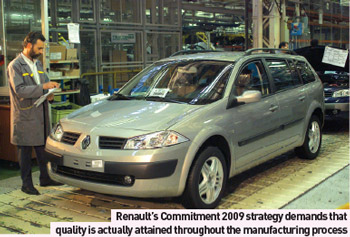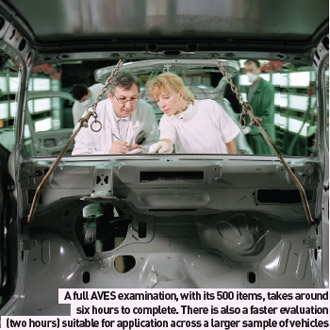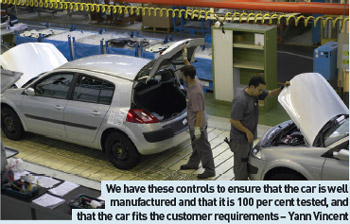Renault has implemented a new customer-focused strategy that makes quality the centrepiece of the company’s manufacturing system. AMS looks at the initiative and talks to senior VP for quality, Yann Vincent, about its effect on productivity
There is not an automotive manufacturer that does not put quality high on its list of manufacturing priorities, and the tools at their disposal continue to grow. Where once quality consisted of pulling a car off the production line and carrying out a quality audit, more and more manufacturers are installing in-line measurement and test in the form of laser measurement and vision systems.
 But successful quality programmes require a holistic view of quality, from parts arriving at the factory gates to the car being delivered to the customer, and must contain an effective feedback mechanism.
But successful quality programmes require a holistic view of quality, from parts arriving at the factory gates to the car being delivered to the customer, and must contain an effective feedback mechanism.
One company that has firmly grasped the quality mantle is Renault, which has made quality improvement part of its three-pronged Renault Commitment 2009 strategy.
Alongside such pivotal strategies as sales growth and operating margins is a strong quality commitment that the X91, the Laguna replacement, will be among the top three cars in its segment in product and service quality in whatever market it is sold. Indicators prove that tangible results on quality have been obtained already, though further efforts will undoubtedly be needed to sustain this impetus. Current Renault models, such as Clio II, Scénic II and Modus, have all achieved high quality but Carlos Ghosn, President and Chief Executive, is demanding more.
Much of the credit for the progress made so far goes to a vehicle design process that inputs quality goals from the very start. The other essential requirement is that quality is actually attained throughout the manufacturing process. With this in mind, new standard processes and methods have seen set up under the Renault Production Way (SPR), placing a strong emphasis on personnel responsibility at Renault production plants.
A number of concrete measures have been taken to enthrone deep-rooted quality as the centrepiece of the Renault manufacturing system: attentive supplier management, fine-tuned operator training, responsive quality leadership at production plants, and systematic application of certain static and dynamic tests on completion of the production process. Then final vehicle quality is validated by a rigorous Alliance-wide scoring system (known as AVES, for Alliance Vehicle Evaluation Standard), examining over 500 criteria.
At the same time, quality improvement actions at production plants are driven by customer feedback, input via the dealer network in real time. Operator training is an essential prerequisite, both for the implementation of standards and for any successful quality drive. Beyond the operational aspect as such, training is the first step toward operator awareness of the importance of quality in each elementary motion.
One of the plants spearheading the quality drive is the Palencia facility, situated north-west of Madrid. The facility employs more than 3,000 workers making the Megane and last year they produced in excess of 260,000 MPVs on its single production line.
At Palencia, much like other Renault facilities around the globe, the company have set up two important shopfloor initiatives: Basic Work Teams and the ‘Checkman’ function.
Renault followed Nissan’s example in setting up a specific job function handling quality control in 2003. The job of the Checkman is to scour vehicles for potential defects before they go on to the next stage in the process. Working directly on the production line, he will point out non-compliances, or actually bar defective units from proceeding further.
The Checkman applies immediate protection, tackling problems at the source by tracking down the workstation at which a defect originates.
This applies from the initial trial runs on each industrial project right through to actual volume production. Once a sustainably high quality level has been reached, with the root causes of problems identified and eradicated, then the number of checkmen can be reduced.
At Palencia, static tests on completion of the production process take place in two phases. First, all basic functions are examined using various test systems. Electrical and electronic functions are checked using a computerised diagnostic tool that queries the vehicle controllers, applying various combinations. Lighting and parallelism are checked on a parallelism bench, while engine, braking, and wiring systems are checked on a rollerbed and water tightness is checked under powerful sprays in a special booth.
Secondly, the vehicle finish is examined in minute detail by specialist operators, whose mission is to take the point of view of an extremely critical customer. This customer satisfaction inspection covers paintwork appearance, closeness and evenness of fit between vehicle parts, operation of doors and windows and operation of certain vehicle controls.
Finally, all vehicles undergo systematic tests on a scaled down track around 350 metres long, located at the end of the production line at Palencia. The track includes various types of road surface (flat asphalt, bumps, cobblestones, humps), to test the vehicle under different driving conditions. The track test examines vehicle axle systems, gearbox, steering and braking. An acoustic examination is also performed to make sure there are no spurious noises.
If an incident or non-compliance is detected at this stage, the test operator will trigger an alert procedure. Customer-focused checklist
The Renault-Nissan AVES system (for Alliance Vehicle Evaluation Standard) was introduced in 2001 to strengthen the existing global quality analysis. Eight vehicles every month are sampled at random for a full customer’s-viewpoint evaluation to a checklist including some 500 static and dynamic items.
 The static examination covers visual and tactile aspects, with close attention to such things as paintwork appearance, mastics, body part fits and equipment.
The static examination covers visual and tactile aspects, with close attention to such things as paintwork appearance, mastics, body part fits and equipment.
The dynamic examination covers noise, comfort, vehicle performance and equipment operation. Scoring is a two person process, with one person running through the checklist and the other performing the checks. As well as being more convenient, this arrangement also ensures that scores are never a matter of a single personal opinion. For reasons of objectivity, the operators performing the evaluation do not belong to the plant they work at.
For each defect detected, a seriousness coefficient is applied, and then all items are totalled to give an overall score for the vehicle.
A full AVES examination, with its 500 items, takes around six hours to complete. There is also a faster evaluation ( two hours) suitable for application across a larger sample of vehicles. This short AVES is carried out on at least two vehicles per day, again sampled at random from the production line.
Fully aware that the quality of its outgoing vehicles depends on the quality of their incoming parts, Renault gives great importance to supplier involvement in quality management. Supplier management at each Renault production site is handled by a specialist Supplier Quality Department that has two main missions, that of prevention and continuous improvement.
From the start of each new vehicle project the department ensures that suppliers benefit from the full breadth of the Renault plant’s experience, and to help them define products that will meet the requirements of the plant’s production system. The department also works hand in hand with the Purchasing Department on the supplier selection process, verifying the capacity of each supplier to meet the plant’s compliance criteria.
Then, during the production phase, it acts on behalf of senior management to control the compliance of all parts entering the company. This responsibility is exercised through permanent monitoring of incoming products. If non-compliance is detected, the supplier concerned is alerted immediately and all batches of parts liable to be affected by the non-compliance are quarantined.
 Thereafter, the department will work with the supplier on corrective action.
Thereafter, the department will work with the supplier on corrective action.
In late 2002, all Renault plants appointed one or more customer quality managers, the aim being to shorten the feedback loop from dealer network to manufacturing plant and thus improve the plants’ response to quality incidents reported by customers.
The customer quality manager focuses exclusively on customer satisfaction. Whenever an incident is reported via the dealer network, the customer quality manager acts as the customer’s ambassador to see that the issue is thoroughly investigated and appropriate problem-solving action taken. This applies to both production and after sales issues. Basically, customer quality managers interface between the dealer network, the production plant and central engineering teams. And they also liaise closely with the supplier quality department.
The man responsible for delivering Carlos Ghosn’s promise of quality is Renault’s Senior Vice President, Quality – Yann Vincent.
 Can you explain how the Renault Commitment 2009 initiative affects the quality process in the assembly hall?
Can you explain how the Renault Commitment 2009 initiative affects the quality process in the assembly hall?
In final assembly, first of all we are relying on what we call auto control – which is control performed by our workers to detect any potential defect whether it is related to the operation that the worker is undertaking or related to the part itself. So, for example, when a worker is fitting a seat, if the worker doesn’t screw the seat to the body at the right value, then he has to write it on paper to enable the car to be reworked afterwards. Or, if he observes a fault on the seat, he also has to record that on paper.
So do you rely entirely on your operatives to spot any quality problems?
We are not only relying on operator control because, even though a car may be well manufactured, it could still have problems. A car is made up of over a thousand different parts and it could happen that a part could be well assembled on the car, but have a problem inside: that is why we have a set of controls on the final product.
We have various electronic tests. We also undertake drive tests at the very end of the manufacturing process on a road track that is approximately 1km long, it is a 100 per cent test on the finished vehicle.
But there are also bench tests where we can test things such as the brakes and gears to check for any problems. We have these controls to ensure that the car is well manufactured and that it is 100 per cent tested, and that the car fits the customer requirements.
What about in the bodyshop, is that also operator driven?
For the body-in-white we have different tools. The first is what we call 1D quality. To collect the data it is necessary for the worker to use a small hand-held device which gives him the opportunity to check that the welding has been carried out correctly.
 Another example is that at the end of the line we have something that looks like a headlamp and we put this device in the place that afterwards we will fit the headlamp, and we check if everything is okay. We are also carry out 1D quality on the sheet metal parts for things such as clearance between the doors and the body parts.
Another example is that at the end of the line we have something that looks like a headlamp and we put this device in the place that afterwards we will fit the headlamp, and we check if everything is okay. We are also carry out 1D quality on the sheet metal parts for things such as clearance between the doors and the body parts.
That is our first control. The second control is CMM machines or 3D machines. We take some cars out of the line, a set number each day or each week, depending on our control plan. We measure a whole set of parameters in order to ensure that there is no drift in the welding process.
The third control, which we haven’t implemented so far in all of our plants, is 3D measurement on-line. We are measuring with lasers certain things to ensure that everything on the body-in-white conforms. Finally, we are also making more and more ultrasonic welding spot checks, in addition to the welding spots checks that we have traditionally undertaken.
With this emphasis on quality does it affect productivity?
There is always a trade off between quality and productivity, but we try as much as possible to avoid stopping the line. Nevertheless, our policy is that if a problem requires that the line be stopped, we will stop it.
Every department of the manufacturing process, body-in-white, paint shop, final assembly and stamping, is divided into teams of about 15-20 workers. For each of these teams there is a team supervisor, who manages all the members of the team and has responsibility for the quality produced by his team and the quantity of cars produced.
In every team we also have a Checkman reporting to the supervisor – a person who has to check all the operations ensuring that the work has been performed correctly – and a Rework man.
Whenever we have a problem that is detected by a worker, the worker may trigger a lamp that lights with the number of his job station. This signals either the supervisor or rework person that there is a problem and that they need to come and look at that problem. If they can fix it without stopping the line that is okay, but if they think that it is impossible to fix the problem without stopping the line, they will stop the line. That is the responsibility of the supervisor or rework person who both have authority to stop the line.
When Carlos Ghosn unveiled his Renault Commitment 2009 earlier the year he put the focus firmly on quality within the Renault Organisation.
Exactly how does the quality commitment impact Renault operations?
Renault Commitment 2009 is a three-part strategy. The first commitment is on quality, which is based on a new model that we currently call X91, this will replace the Laguna in the near future. The commitment is that from the launch of the X91 we will rank among the top three for quality everywhere in the world where we market this car.
The two other commitments are related to profitability, a minimum operating margin of 6 per cent by 2009 and a sales commitment to increase volume by 900,000 between 2005 and 2009.
In order to achieve this quality commitment we have a plan at Renault that is called REP – Renault Excellence Plan. It is a plan aimed at improving quality throughout the entire company. In manufacturing, many of the things that we have spoken about are part of that plan. But we are also very much focusing on the quality of the parts that we buy from suppliers, because more and more of the car comes from outside suppliers. So we are working very hard on how to secure the quality of the parts before we start production and what we require from our suppliers to ensure that everything complies. We are also working on being more preventive after the start of production. We require on either a daily or a weekly basis, depending on the status of suppliers input from their control plan, to ensure that nothing is drifting on quality which could cause a quality problem.













































